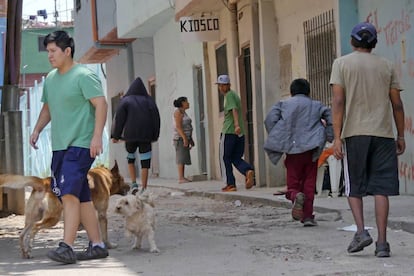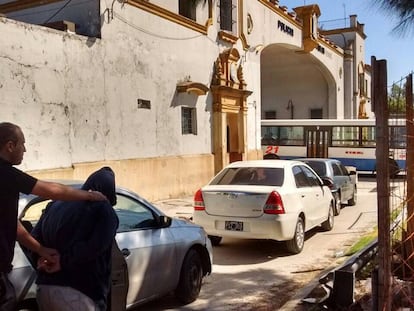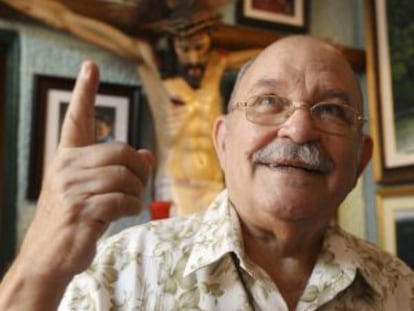The Buenos Aires slum fighting to save its youngsters from drug dealers
Church-led initiative in Argentinean capital offers way to reduce crime among teens
A battle is underway in the slums of Buenos Aires: in Flores, widely regarded as one of the most dangerous areas of the city, and just a few kilometers from its elegant downtown avenues, the Catholic Church, local authorities and residents’ associations are fighting to prevent local boys from being recruited by drug traffickers and organized criminals.

A number of recent murders in Argentina have highlighted a problem that Villa 1-11-14, a shanty town within Flores home to some 70,000 people, has experienced first hand. Two months ago, a 15-year-old of Peruvian-origin killed another boy of the same age here. The courts ruled that as a minor he couldn’t be tried for murder and instead deported him with his grandfather to Peru.
Following widespread anger at the recent wave of killings involving teenagers, the center-right government of President Mauricio Macri has promised to lower the age of criminal responsibility from 16 to 14 in a bid stop the gangs from using minors as cannon fodder.
But Gustavo Carrara, a priest and former colleague of Flores-raised Pope Francis sees things differently.
These neighborhoods are young, they could do so much for the city Father Gustavo Carrara
“This isn’t about kids, this is about their elders. They’re not to blame. Sticking them in jail will only teach them how to steal better. The critical age is 12 to 13,” he says.
“We have to find ways to keep boys in school, which is the last line of defense. They are looking for an identity, to belong to something. And that is something they often find on the corner, selling drugs. We have to give them something else to belong to: for example, a soccer club. What’s more, they need opportunities. If you say that you live in Villa 1-11-14, it’s not easy to find work,” he adds.
Slowly but surely, Carrara and his parishioners have managed to set up a school, a nursery, a social club, a soccer team, and a drug detox center, but there are streets even he will not risk entering – streets where gangs control drug distribution, using children as lookouts.
Kevin, aged 24, was born and raised in Villa 1-11-14. Like most of his friends, he left school early. After three years living “out of control” he became involved in politics and managed to escape. He is now studying to finish his high school diploma and works in a nearby cooperative.
Matías, who came here from Rosario, a city some 100 kilometers north of Buenos Aires, to start a new life, is trying to get off drugs and has seen first-hand how local gangs operate. “Beyond the walls of the club it’s war. They are trapped. They offer them a gun, a videogame, an expensive cellphone, a scooter and a lot of money. The kids are out of control,” he says.
The government wants to lower the age of criminal responsibility
Rodolfo, who grew up in Villa 1-11-14, is part of the neighborhood fightback being led by Father Carrera, and also believes that locking up 14 year olds isn’t going to change anything.
Instead, he works with boys from the area, trying to get them involved in soccer and other activities. He says that slowly but surely, he and Father Carrara have managed to wrest control of some areas of Villa 1-11-14 from the drug dealers. “There was a patch of waste ground near the San Lorenzo stadium [one of the top five teams in Argentina] and we used to go there with the kids to play. At first, they told us to clear off, and there was gunfire and we took refuge in the church with about 30 kids. There are no addicts there now, and we use it. There are no more narcos. Local residents own it now, and the kids play there,” he explains.
Father Carrara believes that while shanty towns like Villa 1-11-14 are the result of Argentina’s decline, they also offer an opportunity, if the right approach is taken. “In 1974, there was 4% poverty in Argentina, it’s now 32%. The kids didn’t do that. There are thousands of children and adolescents in these poor neighborhoods. The average age in the villas is 24, compared to 40 in the rest of the city. These children need play parks, schools, sports, culture, alternative significant adults they can look up to, because often their parents are too busy just working to survive: they work long, long hours to pay the rent,” he says, adding: “There is a law in Buenos Aires that forbids the use of horses to pull carts, but we have come to accept seeing kids who collect cardboard pulling them. These neighborhoods are young, they could do so much for the city: domestic help, looking after people, cleaning, construction. But it all requires time and resources. This isn’t going to be fixed with more prisons.”
English version by Nick Lyne.
Tu suscripción se está usando en otro dispositivo
¿Quieres añadir otro usuario a tu suscripción?
Si continúas leyendo en este dispositivo, no se podrá leer en el otro.
FlechaTu suscripción se está usando en otro dispositivo y solo puedes acceder a EL PAÍS desde un dispositivo a la vez.
Si quieres compartir tu cuenta, cambia tu suscripción a la modalidad Premium, así podrás añadir otro usuario. Cada uno accederá con su propia cuenta de email, lo que os permitirá personalizar vuestra experiencia en EL PAÍS.
¿Tienes una suscripción de empresa? Accede aquí para contratar más cuentas.
En el caso de no saber quién está usando tu cuenta, te recomendamos cambiar tu contraseña aquí.
Si decides continuar compartiendo tu cuenta, este mensaje se mostrará en tu dispositivo y en el de la otra persona que está usando tu cuenta de forma indefinida, afectando a tu experiencia de lectura. Puedes consultar aquí los términos y condiciones de la suscripción digital.










































